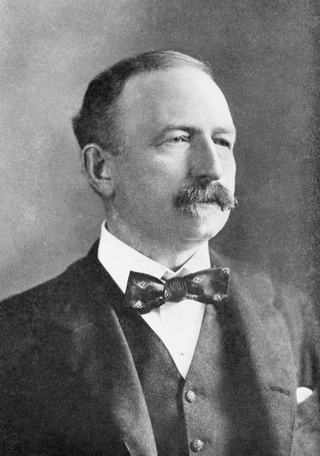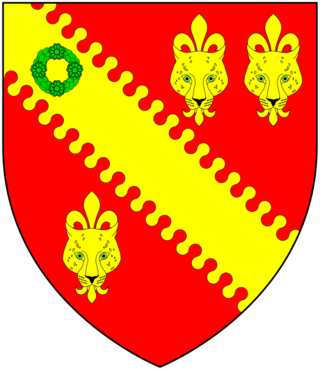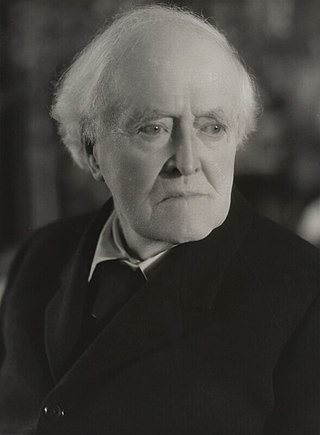
Earl of Carlisle is a title that has been created three times in the Peerage of England.

Earl of Buckinghamshire is a title in the Peerage of Great Britain. It was created in 1746 for John Hobart, 1st Baron Hobart.

Earl of Wilton, of Wilton Castle in the County of Herefordshire, is a title in the Peerage of the United Kingdom. It was created in 1801 for Thomas Egerton, 1st Baron Grey de Wilton, along with the subsidiary title of Viscount Grey de Wilton, also in the Peerage of the United Kingdom. Both titles were created with remainder to the second and all younger sons successively of his daughter Eleanor, wife of Robert Grosvenor, 1st Marquess of Westminster.

Earl Granville is a title that has been created twice, once in the Peerage of Great Britain and once in the Peerage of the United Kingdom. It is now held by members of the Leveson-Gower family.

Earl Cawdor, of Castlemartin in the County of Pembroke, is a title in the Peerage of the United Kingdom. It was created in 1827 for John Campbell, 2nd Baron Cawdor.

Viscount Chelmsford, of Chelmsford in the County of Essex, is a title in the Peerage of the United Kingdom. It was created in 1921 for Frederic Thesiger, 3rd Baron Chelmsford, the former Viceroy of India. The title of Baron Chelmsford, of Chelmsford in the County of Essex, was created in the Peerage of the United Kingdom in 1858 for the first Viscount's grandfather, the lawyer and Conservative Sir Frederic Thesiger, who twice served as Lord Chancellor of Great Britain. Then following was the 2nd Baron, who gained the rank of general and was awarded. As of 2010 the titles are held by the first Viscount's great-grandson, the fourth Viscount, who succeeded his father in 1999.

Baron Ashtown, of Moate in the County of Galway, is a title in the Peerage of Ireland. It was created in 1800 for Frederick Trench, with remainder to the heirs male of his father.

Baron Hotham, of South Dalton in the County of York, is a title in the Peerage of Ireland. It was created in 1797 for the naval commander Admiral William Hotham, with remainder to the heirs male of his father. Hotham was the third son of Sir Beaumont Hotham, 7th Baronet, of Scorborough, and in 1811 he also succeeded his nephew as eleventh Baronet. Lord Hotham never married and on his death in 1813 he was succeeded in both titles by his younger brother Beaumont, the second Baron and twelfth Baronet. He had previously represented Wigan in the House of Commons.

Baron Heytesbury, of Heytesbury in the County of Wiltshire, is a title in the Peerage of the United Kingdom. It was created in 1828 for the prominent politician and diplomat Sir William à Court, 2nd Baronet, who later served as Ambassador to Russia and as Viceroy of Ireland. His son, the second Baron, sat as Member of Parliament for the Isle of Wight. On his marriage in 1837 to Elizabeth Holmes, daughter of Sir Leonard Worsley Holmes, Lord Heytesbury assumed the additional surname of Holmes. His son the 4th baron commanded a battalion in the Wiltshire Regiment and was for a time in command of 62nd (Wiltshire) Regiment of Foot. As of 2010, the titles are held by his great-great-great-grandson, the seventh Baron, who succeeded his father in 2004.

Baron Gifford, of St Leonard's in the County of Devon, is a title in the Peerage of the United Kingdom. It was created on 30 January 1824 for the lawyer Sir Robert Gifford, who later served as Master of the Rolls. His grandson, the third Baron, was a soldier and colonial administrator and was awarded the Victoria Cross in 1874. On his death the title passed to his younger brother, the fourth Baron, and then to their nephew, the fifth Baron. As of 2010 the title is held by the latter's son, the sixth Baron, who succeeded in 1961. He is a barrister.

Baron Glenarthur, of Carlung in the County of Ayr, is a title in the Peerage of the United Kingdom. It was created in 1918 for the Scottish businessman Sir Matthew Arthur, 1st Baronet. He had already been created a baronet, of Carlung in the County of Ayr, on 28 November 1902. The title of the barony was derived from the joining of his mother's maiden surname name of Glen and his patronymic Arthur.

Baron Abinger, of Abinger in the County of Surrey and of the City of Norwich, is a title in the Peerage of the United Kingdom. It was created on 12 January 1835 for the prominent lawyer and politician Sir James Scarlett, the Lord Chief Baron of the Exchequer. Lord Abinger was succeeded by his eldest son, the second baron. He represented Norwich and Horsham in the House of Commons. He was succeeded by his son, the third baron. He was a lieutenant-general in the army and fought in the Crimean War. On the death of his son, the fourth baron, the line of the eldest son of the first baron failed. The late baron was succeeded by his second cousin, the fifth baron. He was the grandson of Peter Campbell Scarlett, third son of the first baron. When he died the title passed to his younger brother, the sixth baron, and then to another brother, the seventh baron. As of 2016 the title is held by the latter's grandson, the ninth baron, who succeeded his father in 2002.
Baron Addington, of Addington in the County of Buckingham, is a title in the Peerage of the United Kingdom. It was created on 22 July 1887 for the businessman and Conservative Member of Parliament, John Hubbard. He was head of the firm of John Hubbard & Co and also sat as a Member of Parliament for Buckingham and the City of London. His eldest son, the second Baron, was a partner in the family firm and represented Buckingham in the House of Commons as a Conservative. He was succeeded by his eldest son, the third Baron. He was three times Mayor of Buckingham. On the death of his younger brother, the fourth Baron, the line of the eldest son of the first Baron failed. The title passed to their first cousin once removed, the fifth Baron. He was the grandson of Cecil John Hubbard, third son of the first Baron. As of 2018, the title is held by his eldest son, the sixth Baron. He is one of the ninety elected hereditary peers that remain in the House of Lords after the passing of the House of Lords Act of 1999. Lord Addington sits on the Liberal Democrat benches.

Baron Shaughnessy, of the City of Montreal in the Dominion of Canada and of Ashford in the County of Limerick, is a title in the Peerage of the United Kingdom. It was created in 1916 for the Milwaukee born businessman Thomas Shaughnessy, president of the Canadian Pacific Railway Company. He was succeeded by his eldest son, the second Baron, a Director of the CPR and of the Canadian Bank of Commerce. His son, the third Baron, was a businessman and was also active in the House of Lords. However, he lost his hereditary seat in parliament after the House of Lords Act 1999.

Baron Merthyr, of Senghenydd in the County of Glamorgan, is a title in the Peerage of the United Kingdom. It was created in 1911 for the Welsh coal mining magnate Sir William Lewis, 1st Baronet. He had already been created a baronet, of Nantgwyne in the County of Glamorgan, in 1896. The barony is named after the town of Merthyr Tydfil, where Lewis was born. Lord Merthyr's grandson, the third Baron, was Chairman of Committees in the House of Lords from 1957 to 1965 and a Deputy Speaker from 1957 to 1974. The latter was succeeded by his son, the fourth Baron. He disclaimed the peerage for life on 26 April 1977, three weeks after succeeding his father. He did not use his title of baronet either. He died on 5 August 2015.

Baron Tennyson, of Aldworth in the County of Sussex and of Freshwater in the Isle of Wight, is a title in the Peerage of the United Kingdom. It was created in 1884 for the poet Alfred Tennyson. His son, the second Baron, served as Governor-General of Australia, and his grandson, the third Baron, as a captain for the English cricket team. On the death in 2006 of the latter's younger son, the fifth Baron, the line of the eldest son of the first Baron failed. The title was inherited by the late Baron's second cousin once removed, the sixth and present holder of the peerage. He is the great-grandson of Hon. Lionel Tennyson, second son of the first Baron.

Baron Trevethin, of Blaengawney in the County of Monmouth, is a title in the Peerage of the United Kingdom. It was created in 1921 for the prominent judge Sir Alfred Lawrence, Lord Chief Justice of England from 1921 to 1922.
Baron Congleton, of Congleton in the County Palatine of Chester, is a title in the Peerage of the United Kingdom. It was created in 1841 for the Whig politician and former Secretary at War and Paymaster of the Forces Sir Henry Parnell, 4th Baronet. His eldest son, the second Baron, devoted his life to religious work and was an early member of the Plymouth Brethren. The latter was succeeded by his younger brother, the third Baron. He served in the Royal Navy and fought at the Battle of Navarino in 1827. His eldest surviving son, the fourth Baron, was a major-general in the British Army and served in the Crimean War and in the Anglo-Zulu War. The latter's eldest son, the fifth Baron, was killed in action in Ypres Salient during the First World War and was succeeded by his younger brother, the sixth Baron. As of 2015, the titles are held by the latter's grandson, the ninth Baron, who succeeded his father in 2015.

Charles Alfred Cripps, 1st Baron Parmoor, was a British politician who crossed the floor from the Conservative to the Labour Party and was a strong supporter of the League of Nations and of Church of England causes.

Earl of Arran is a title in the Peerage of Ireland. It is not to be confused with the title Earl of Arran in the Peerage of Scotland. The two titles refer to different places: the Aran Islands in Ireland, and the Isle of Arran in Scotland. The Irish earldom is held by the Gore family. The Scottish earldom is a separate title, held as a subsidiary title of the Duke of Hamilton.

















